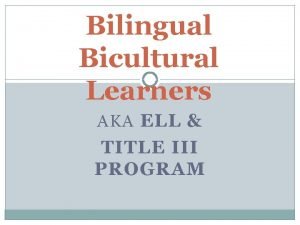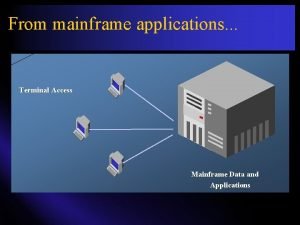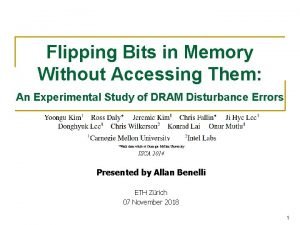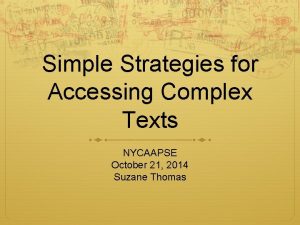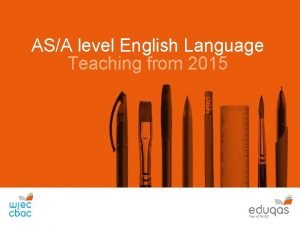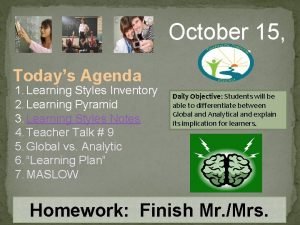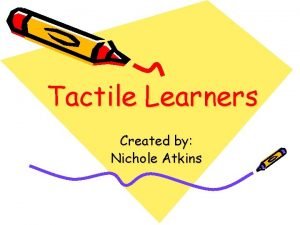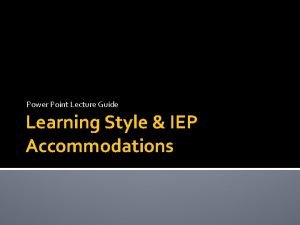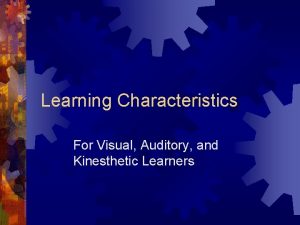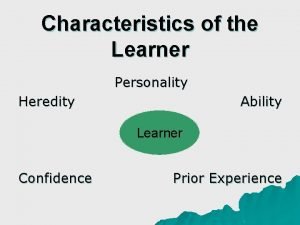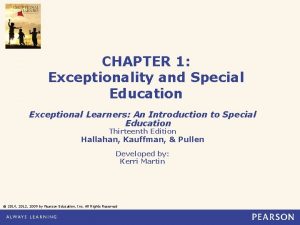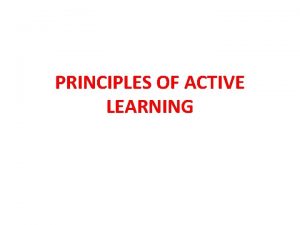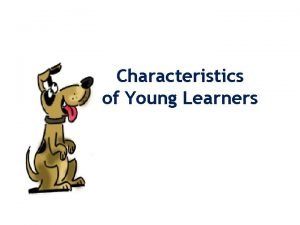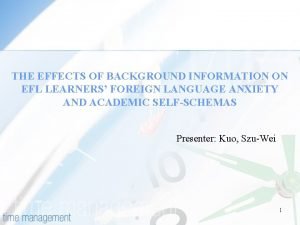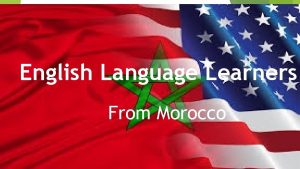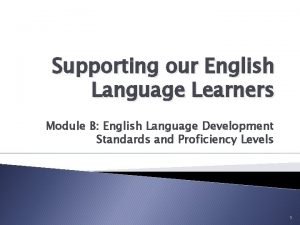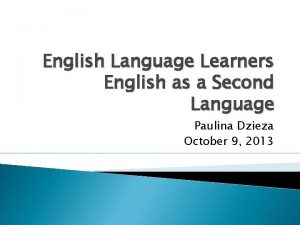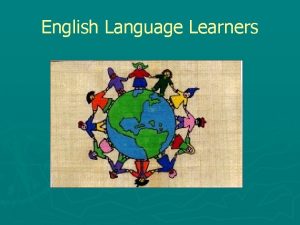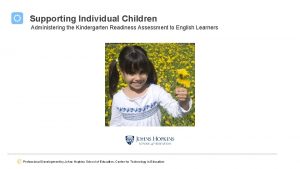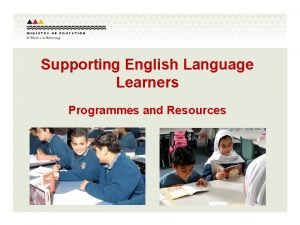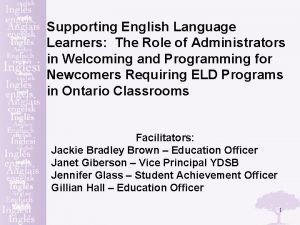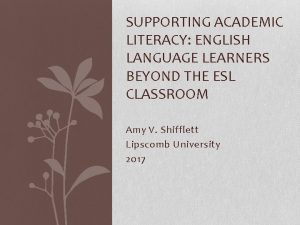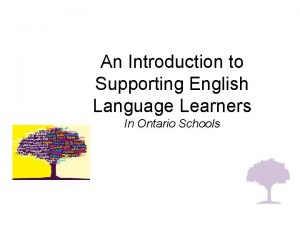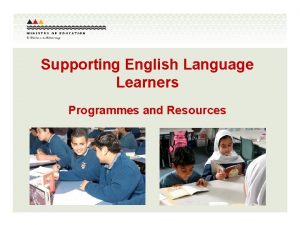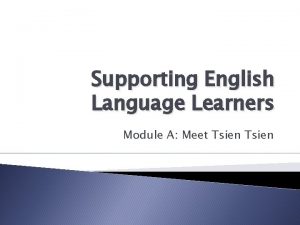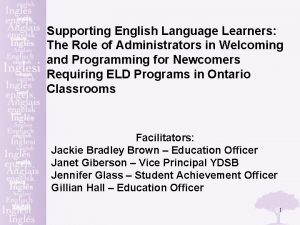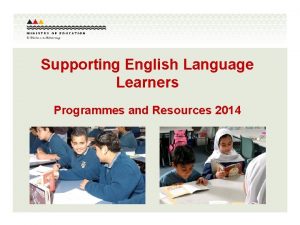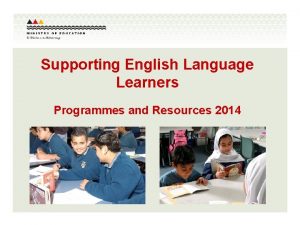Language Analysis Supporting English Learners in Accessing Informational

































- Slides: 33

Language Analysis: Supporting English Learners in Accessing Informational Texts CCSS ELA/Literacy Showcase June 24, 2013 Presented by Danielle Garegnani English Learner Support Teacher Sherman Elementary, San Diego Unified School District dgaregnani@sandi. net

Session Outcomes Participants will: • Examine the complex features of academic language • Examine some of the language features and patterns of informational texts • Engage in text analysis of informational texts • Engage in activities that support student understanding and use of the language features of informational texts

Functional Grammar • Based on Halliday’s socio-cultural theory of language learning- Systemic Functional Linguistics (SFL) • The function of language is to make meaning • Language is produced based on choices of the speaker/writer in relation to demands of the context • Texts are produced for different purposes; the lexical and grammatical features of these texts are influenced by the purpose and context Eggins, 2004


CCSS - Challenges for ELs The language patterns of different content areas (the lexico-grammatical features and syntactic structures) make it more difficult for students, especially ELs, to understand use academic language. Common Core State Standards AND Next Generation ELD Standards

Challenges of Academic Language. Clause Linking “Because the climate is dry, farmers there must use irrigation to water their fields. However, the Central Valley has one of the country’s longest growing seasons. ” Harcourt Social Studies, grade 4 “As a seed begins to sprout, a root grows from it. Next, the seed breaks open and a young plant, or seedling, appears. ” Harcourt Science, grade 3

Challenges of Academic Language. Referencing “Most newcomers arrived in California with only what they could carry. These people needed places to live, food to eat, clothes to wear, and much more. This created demand for workers of many kinds. Carpenters built homes and buildings, and merchants sold supplies. ” Harcourt Social Studies, grade 4

Challenges of Academic Language. Lexical Density “When a river slows down, it drops sediment that builds up in layers at the bottom of rivers, lakes, seas, and oceans, which press and stick together to form sedimentary rock. ” Harcourt Science, grade 3

Challenges of Academic Language. Nominalization “After weathering has broken the rock into sediment, erosion and deposition cause the particles to build up as new sand on beaches. Over time, sedimentation forms new rocks on the beach. This formation of new rock is made up of several layers. ” Harcourt Science, grade 5

Metalanguage We need to give our students the linguistic resources to access, understand, and use the language required for academic tasks (Schleppegrell, 2013) • Highlight and explicitly teach language function and forms in context • Engage students in talk about those functions and forms • Provide opportunity to practice the language in context • Connect the language to other areas

Academic Content and Language Learning new content is not separate from the development of the language that constructs the new knowledge The Language of Schooling involves: • Learning Language (vocabulary and forms) • Learning Through Language (content) • Learning About Language (how it works and is used-its function) Schleppegrell, 2004

Literacy & Language Across the Content Areas Good literacy teaching isn’t something added to an already crowded curriculum; it isn’t the icing on the cake, but the ingredients of it! Instead of thinking in terms of “covering the content, ” we must think in terms of “uncovering the subject. ” Gibbons, 2009

Language features/patterns of descriptive texts SEE HANDOUT

Language features/patterns of causal & sequential explanation texts SEE HANDOUT

What are some of the text types students are required to read/write? Narrative Informational/ Explanatory Argument Personal Recount Informational Report Exposition Fictional Story Procedural Discussion Historical Recount Explanation Response to Literature Summary Response to Literature Purpose Describing Comparing and Contrasting Explaining- sequential and causal Persuading Instructing Recounting

Kindergarten Starfish have arms, but no legs. Starfish have feet, but no toes. They glide and slide on tiny tube feet. They move as slowly as a snail. Tiny brittle stars hide under rocks on pools by the sea. The mud star hides in the mud. When a starfish is hungry, it hunts for mussels, oysters, and clams. Starfish by Edith Thacher Hurd

Kindergarten Starfish have arms, *but no legs. Starfish have feet, *but no toes. They glide and slide on tiny tube feet. They move as slowly as a snail. *don’t have Tiny brittle stars hide under rocks on pools by the sea. The mud star hides in the mud. When a starfish is hungry, it hunts for mussels, oysters, and clams. Starfish by Edith Thacher Hurd

First Grade Pumpkin plants don’t stand up tall. As the stems grow longer, they sprawl all over the ground. Before long, twisted, tangles vines cover the pumpkin patch. Soon, flower buds appear on the vines. After each bud opens, its orange petals grow bigger and bigger. They look like bright orange umbrellas. From Seed to Pumpkin by Wendy Pfeffer

First Grade Pumpkin plants don’t stand up tall. As the stems grow longer, they sprawl all over the ground. Before long, twisted, tangled vines cover the pumpkin patch. Soon, flower buds appear on the vines. After each bud opens, its orange petals grow bigger and bigger. They look like bright orange umbrellas. From Seed to Pumpkin by Wendy Pfeffer

Second Grade Turn over a good-size brook boulder and look closely at the wet surface. Chances are you will see a tiny aquatic insects crawling on it. The nymphs, or beginning stages of mayflies, stone flies, and other stream-borne flies, live on submerged rocks, where they feed on microscopic organisms. Nymphs’ flat bodies allow them to crawl under and not be crushed by the heavy stream boulders. The Brook Book: Exploring the Smallest Streams by Jim Arnosky

Second Grade Turn over a good-size brook boulder and look closely at the wet surface. Chances are you will see tiny aquatic insects crawling on it. The nymphs, or beginning stages of mayflies, stone flies, and other stream-borne flies, live on submerged rocks, where they feed on microscopic organisms. Nymphs’ flat bodies allow them to crawl under and not be crushed by the heavy stream boulders. The Brook Book: Exploring the Smallest Streams by Jim Arnosky

Third Grade Outside the glass, the water evaporates and spreads throughout the room as vapor. In time, the drops disappear. In the glass, water also evaporates, but the vapor is trapped. The air inside the glass becomes humid, which means that the air is full of water vapor. And that vapor condenses back onto the water drops as quickly as water molecules can evaporate. Therefore, the drops remain. A Drop of Water: A Book of Science and Wonder by Walter Wick

Third Grade Outside the glass, the water evaporates and spreads throughout the room as vapor. In time, the drops disappear. In the glass, water also evaporates, but the vapor is trapped. The air inside the glass becomes humid, which means that the air is full of water vapor. And that vapor condenses back onto the water drops as quickly as water molecules can evaporate. Therefore, the drops remain. A Drop of Water: A Book of Science and Wonder by Walter Wick

Fourth Grade Horses move in four natural ways, called gaits or paces. They walk, trot, canter, and gallop. The walk is the slowest gait and the gallop is the fastest. When a horse walks, each hoof leaves the ground at a different time. It moves one hind leg first, and then the front leg on the same side; then the other hind leg and the other front leg. When a horse walks, its body swings gently with each stride. Horses by Seymour Simon

Fourth Grade Horses move in four natural ways, called gaits or paces. They walk, trot, canter, and gallop. The walk is the slowest gait and the gallop is the fastest. When a horse walks, each hoof leaves the ground at a different time. It moves one hind leg first, and then the front leg on the same side; then the other hind leg and the other front leg. When a horse walks, its body swings gently with each stride. Horses by Seymour Simon

Fifth Grade The Martian ice cap has canyons that plunge as much as three thousand feet beneath the surface. The canyons are formed by winds cutting through the ice and by the evaporation of water in the atmosphere. Scientists believe that an ocean with ten times the amount of water in the ice cap once existed on Mars. They think that the remaining water not in the north polar ice cap is stored below the surface and in the much smaller south polar cap, or else it has been lost in space. Destination Mars by Seymour Simon

Fifth Grade The Martian ice cap has canyons that plunge as much as three thousand feet beneath the surface. The canyons are formed by winds cutting through the ice and by the evaporation of water in the atmosphere. Scientists believe that an ocean with ten times the amount of water in the ice cap once existed on Mars. They think that the remaining water not in the north polar ice cap is stored below the surface and in the much smaller south polar cap, or else it has been lost in space. Destination Mars by Seymour Simon

Activities to Support Student Understanding and Use of Language Features • Text Analysis • Theme-Rheme Analysis • Sentence Deconstruction • Sentence Reconstruction • Text Reconstruction • Building Complex Sentences

How can teachers incorporate language analysis into instruction? SHARED READING 1. Use familiar text- no “cold” reads Ø Read and discuss the “gist” of the text first Ø Discuss overall organization, text features, the big idea 2. Introduce one feature at a time Ø Explicitly call students’ attention to the feature and teach the function Ø Analyze one grammatical feature at a time- highlight the form and use guiding questions to discuss its function 3. Analyze the text sentence-by-sentence/clause-by-clause. 4. Deconstruct and analyze the text in small chunks- one sentence/paragraph/page at a time 5. Incorporate language analysis activities

How can teachers incorporate and explicitly teach language analysis in writing instruction? Explicit Instruction and the Curriculum Cycle (Gibbons, 2001) Stage 1 Building the Field ØActivate background knowledge of the topic ØRead and discuss the “gist” of the text-Shared Reading approach Stage 2 Modeling the Text ØHighlight/teach organization & structure ØHighlight/teach grammar features & functions ØAnalyze text ØEngage students in activities to practice the target language forms ØModel writing a text of the genre Stage 3 Joint Construction ØCo-construct a text of the genre- teacher and students contribute Stage 4 Independent Writing ØStudents write their own text

How can language analysis support student reading comprehension? • It supports reading comprehension by providing access to the deeper meaning of the text • It heightens their awareness of the language of the genre/text type • It slows students down, making them focus on the details of the information which is realized through the language • It helps students focus on the macro and micro levels of academic texts (discourse, text type, structure & organization, form) and gives them metalanguage to talk about academic content

How can language analysis support student writing? • It scaffolds writing by raising awareness and focusing on the language features and structures of the text types students have to produce • It expands their linguistic repertoire and gives them the resources they need to write in the content areas • It allows for practice using the language features in context of an academic task

In the absence of an explicit focus on language, children from certain linguistic and socio-economic backgrounds continue to be privileged and others to be disadvantaged in learning, assessment, and promotion, perpetuating the obvious inequalities that exist today. Schleppegrell, 2004
 Assistive technology for english language learners
Assistive technology for english language learners English language learners
English language learners Reading strategies for english language learners
Reading strategies for english language learners Equal protection for english language learners
Equal protection for english language learners Teaching young learners english
Teaching young learners english Accessing i/o devices
Accessing i/o devices Accessing io devices in computer organization
Accessing io devices in computer organization Accessing mainframe data from java
Accessing mainframe data from java Flipping bits in memory without accessing them
Flipping bits in memory without accessing them What allows the replication of only immutable files
What allows the replication of only immutable files Dawnlodaimg and accessing
Dawnlodaimg and accessing Accessing input output devices
Accessing input output devices Accessing complex texts
Accessing complex texts A level english language language change
A level english language language change Global vs analytical learners
Global vs analytical learners What is grammar
What is grammar Tactile learner definition
Tactile learner definition Remedial teaching methods
Remedial teaching methods Global vs analytical learners
Global vs analytical learners Auditory learner characteristics
Auditory learner characteristics Eager learning algorithm
Eager learning algorithm Kinesthetic learners definition
Kinesthetic learners definition When is cognitivism beneficial for learners
When is cognitivism beneficial for learners Domain 3 diversity of learners examples
Domain 3 diversity of learners examples Code of ethics article 6
Code of ethics article 6 Characteristic of learners
Characteristic of learners Exceptional learners: an introduction to special education
Exceptional learners: an introduction to special education Principles of active learning
Principles of active learning Involuntary attention meaning
Involuntary attention meaning 3b using questioning and discussion techniques
3b using questioning and discussion techniques Background information for learners
Background information for learners Rigor relevance quadrants
Rigor relevance quadrants Gifted education curriculum in the philippines
Gifted education curriculum in the philippines Famous intrapersonal person
Famous intrapersonal person

